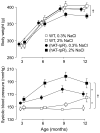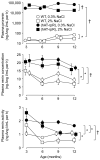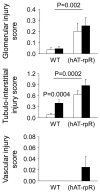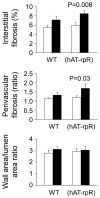Increased dietary NaCl potentiates the effects of elevated prorenin levels on blood pressure and organ disease
- PMID: 20453664
- PMCID: PMC2892532
- DOI: 10.1097/HJH.0b013e3283391f13
Increased dietary NaCl potentiates the effects of elevated prorenin levels on blood pressure and organ disease
Abstract
Background: Rats with several 100-fold elevation of plasma prorenin levels due to liver-specific expression of a rat prorenin transgene have cardiac and aortic hypertrophy, renal lesions, and myocardial fibrosis. The effect of increased dietary NaCl on the phenotype of prorenin transgenic rats has not been examined.
Methods and results: We compared the effects of 0.3 and 2% dietary NaCl in wild-type and transgenic rats from 3 to 12 months of age. In comparison with wild-type rats, transgenic rats receiving 0.3% dietary NaCl had approximately 1000-fold elevation of prorenin, 1.5-fold to 2.5-fold elevation of renin concentration and activity, wild-type levels of angiotensin II, and were hypertensive with cardiac and aortic hypertrophy, and increased renal glomerular and tubulo-interstitial injury score. In wild-type rats, 2% dietary NaCl reduced angiotensin levels, produced a delayed increase in blood pressure, and caused cardiac hypertrophy and tubulo-interstitial injury. By contrast, 2% NaCl did not reduce angiotensin levels in transgenic rats, potentiated their hypertension, cardiac and aortic hypertrophy, and increased myocardial interstitial and perivascular fibrosis, without effect on glomerular or tubulo-interstitial injury score.
Conclusion: Increased dietary NaCl had a greater impact on the phenotype of transgenic than wild-type rats that may have been due, in part, to their hypertension and their failure to suppress angiotensin levels, consequent to their elevated prorenin levels.
Figures






Similar articles
-
Prorenin contributes to angiotensin peptide formation in transgenic rats with rat prorenin expression targeted to the liver.Hypertension. 2009 Dec;54(6):1248-53. doi: 10.1161/HYPERTENSIONAHA.109.138495. Epub 2009 Oct 19. Hypertension. 2009. PMID: 19841286
-
High salt intake damages the heart through activation of cardiac (pro) renin receptors even at an early stage of hypertension.PLoS One. 2015 Mar 23;10(3):e0120453. doi: 10.1371/journal.pone.0120453. eCollection 2015. PLoS One. 2015. PMID: 25799069 Free PMC article.
-
Prorenin independently causes hypertension and renal and cardiac fibrosis in cyp1a1-prorenin transgenic rats.Clin Sci (Lond). 2018 Jun 28;132(12):1345-1363. doi: 10.1042/CS20171659. Print 2018 Jun 29. Clin Sci (Lond). 2018. PMID: 29848510 Free PMC article.
-
Renin/prorenin receptors.Kidney Int. 2006 May;69(9):1503-6. doi: 10.1038/sj.ki.5000265. Kidney Int. 2006. PMID: 16672920 Review.
-
Prorenin uptake in the heart: a prerequisite for local angiotensin generation?J Mol Cell Cardiol. 2002 Nov;34(11):1463-72. doi: 10.1006/jmcc.2002.2078. J Mol Cell Cardiol. 2002. PMID: 12431445 Review.
References
-
- Campbell DJ. Critical review of prorenin and (pro)renin receptor research. Hypertension. 2008;51:1259–1264. - PubMed
-
- van den Heuvel M, Batenburg WW, Danser AH. Diabetic complications: A role for the prorenin-(pro)renin receptor-TGF-beta(1) axis? Mol Cell Endocrinol. 2009;302:213–218. - PubMed
-
- Nussberger J, de Gasparo M, Juillerat L, Guyenne TT, Mooser V, Waeber B, Brunner HR. Rapid measurement of total and active renin: plasma concentrations during acute and sustained converting enzyme inhibition with CGS 14824A. Clin Exp Hypertens [A] 1987;9:1353–1366. - PubMed
-
- Campbell DJ, Kladis A, Skinner SL, Whitworth JA. Characterization of angiotensin peptides in plasma of anephric man. J Hypertens. 1991;9:265–274. - PubMed
Publication types
MeSH terms
Substances
Grants and funding
LinkOut - more resources
Full Text Sources
Medical

